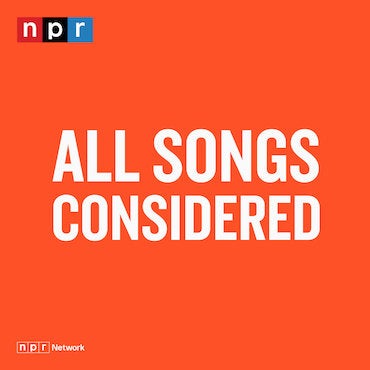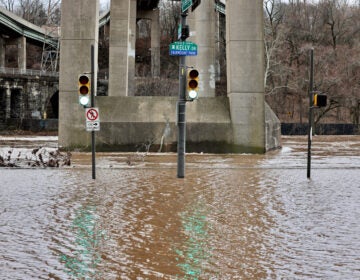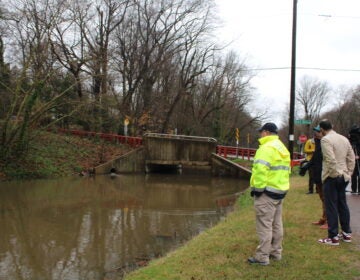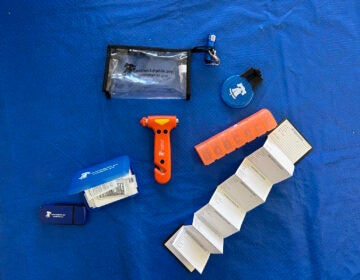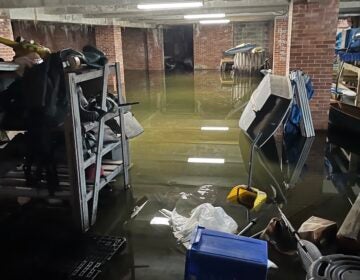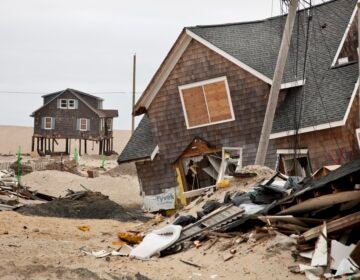Don’t be fooled by these common flood insurance myths in the Philly region
Philly-area insurance officials break down three common misconceptions around financial protection from flood damage.
Listen 1:15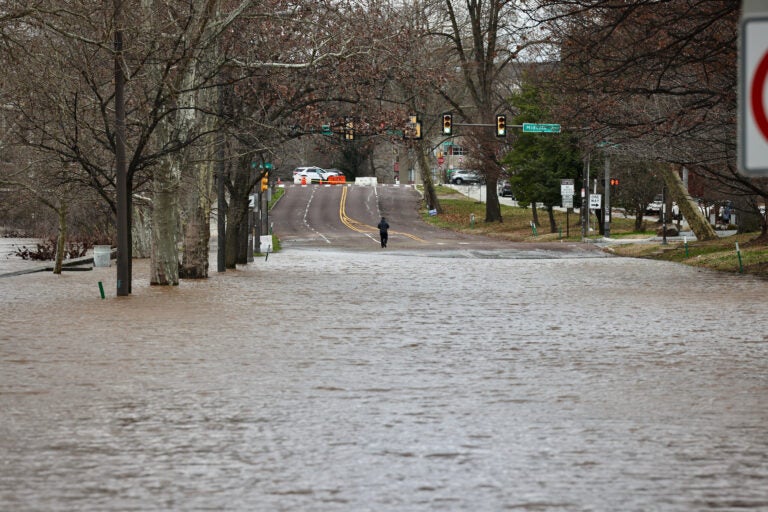
The Schuylkill River floods Kelly Drive at North Ferry Road, closing it in both directions from Midvale Avenue to West Hunting Park Avenue. (Emma Lee/WHYY)
Have a question about Philly’s neighborhoods or the systems that shape them? PlanPhilly reporters want to hear from you! Ask us a question or send us a story idea you think we should cover.
The Philadelphia region is vulnerable to flooding, whether it’s from storm surge along the Jersey Shore, intense thunderstorms dumping rain on Pennsylvania counties or flooding exacerbated by sea level rise along the Delaware Bay. The East Coast could be in for an “extraordinary” hurricane season this year, forecasters say.
A flooded home can be financially devastating for a family. Insurance officials say flood insurance is a good way to protect your bank account and rebuild faster. But they often hear confusion about flood insurance from people whose homes it could help protect.
“A real significant challenge, I think, is misinformation,” said Pennsylvania Insurance Commissioner Michael Humphreys.
Here are three common myths to bust:
Myth No. 1: My home insurance covers flood damage
Truth: Standard home insurance policies typically don’t cover flood damage
People often think they don’t need flood insurance because their home insurance will cover flood damage. It’s not until after their home floods that many realize that’s not the case.
“Flood insurance is not part of your standard policies written for homeowners, businesses, condominiums and renters insurance,” said Justin Zimmerman, acting commissioner of the New Jersey Department of Banking and Insurance.
New Jersey requires homeowners insurance providers to explicitly notify policyholders of this fact.
The Federal Emergency Management Agency defines flooding as the inundation of two or more acres or two or more properties that are usually dry by inland or tidal waters; runoff of surface waters; mudslides; or the collapse of land along a body of water because of erosion.
Most standard home insurance policies cover water damage from burst pipes or suddenly broken appliances, but not damage from flooding.
Flood insurance policies, on the other hand, can cover damage to your home, utilities and personal belongings as a direct result of a flood — even flood preparation items like pumps and sandbags.
Even if you have flood insurance, make sure you understand the details and limitations of the policy, said Delaware Insurance Commissioner Trinidad Navarro. He’s seen residents who carry flood insurance still need to pay out of pocket to fix flood damage.
“There were folks who had flood insurance but had left valuable items on the basement floor or the first level of the dwelling and suffered damage, and it wasn’t covered — and it was spelled out in the policy,” Navarro said. “People don’t necessarily read their policies and completely understand what’s in it.”
Myth No. 2: If I live outside the FEMA flood zone, I can’t get flood insurance
Truth: Officials say you can and should consider flood insurance even outside the high-risk zone
Another misconception insurance officials hear from residents is that people living outside FEMA’s Special Flood Hazard Area cannot buy flood insurance.
“But that’s not correct,” Zimmerman said. “Individuals across New Jersey can purchase flood insurance. They do not have to be in a designated area.”
Homes inside FEMA’s Special Flood Hazard Area, or the high-risk area where floodplain management regulations must be enforced, are required to carry flood insurance when they have a government-backed mortgage. But there’s nothing stopping a homeowner without a mortgage or whose home is located outside of this high-risk zone from purchasing flood insurance.
In fact, insurance officials say you should consider buying flood insurance even if you live outside the Special Flood Hazard Area. They say it’s often cheaper outside that zone.
“Every Delawareean should at least inquire about it,” Navarro said. “If you don’t live in an area that has a flood history, it’s relatively inexpensive.”
Navarro said he’s been seeing flood damage in parts of Delaware that did not used to flood.
“Places in Wilmington, places … in the City of New Castle and also, believe it or not, on Main Street in Newark,” Navarro said. “It’s happening all up and down the state.”
It can flood anywhere in Pennsylvania, too, Humphreys said.
“Where it rains, it can flood,” he said. “Just one inch of flood in your house can cause upwards of $25,000 in damage.”
Around 40% of claims through the National Flood Insurance Program come from outside the Special Flood Hazard Area, according to FEMA.
Myth No. 3: I can only get flood insurance from the federal government
Truth: Private companies in Pennsylvania, New Jersey and Delaware offer flood insurance policies
Many people think that all flood insurance comes from the federal government, Navarro said.
“While many — most — are within the National Flood Insurance Program, you can also purchase insurance outside of the NFIP,” he said.
Insurance officials in the Philly region are working to grow the private flood insurance market, encourage competition and offer consumers a variety of options to fit their needs.
More than 20 different companies now offer flood insurance in New Jersey as standalone policies or add-ons to homeowners’ insurance policies — a number that grew since Hurricane Sandy walloped the state in 2012, Zimmerman said.
Some private policies can be purchased in tandem with an NFIP policy through FEMA, for customers that need additional coverage, Navarro said. Other private policies offer lower levels of coverage.
“Even a limited amount of flood insurance coverage is really an important consumer protection,” Humphreys said.
Flood insurance is also available to renters in the form of contents-only policies. Such policies through the National Flood Insurance Program can cover up to $100,000 worth of damaged belongings, from televisions to clothing to bath mats.
If you’re considering buying flood insurance, Zimmerman recommends reviewing your coverage and comparing policies sooner rather than later. National Flood Insurance Program insurance typically does not become effective until 30 days after it’s purchased.

Get daily updates from WHYY News!
WHYY is your source for fact-based, in-depth journalism and information. As a nonprofit organization, we rely on financial support from readers like you. Please give today.

